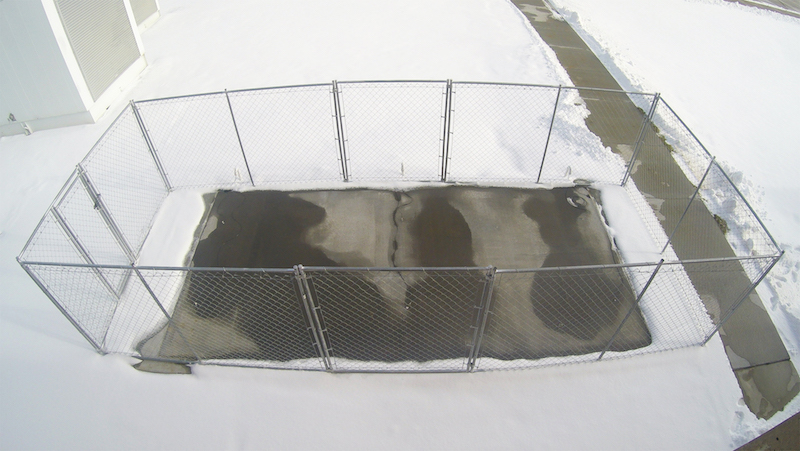Anyone who has driven for any considerable length in bad winter weather has had that moment of panic when one second you feel completely in control of the automobile and the next you feel like a bull rider just trying to hang on for dear life.
Hitting a patch of black ice is scary enough when the outcome is nothing more than a brief moment of wheel spin or slight fishtailing. But the end result to a slippery, snow-covered road can be far worse. From fender benders to fatal accidents, driving in bad winter weather is downright dangerous.
Enter Dr. Chris Tuan, a professor of civil engineering at the University of Nebraska. Tuan has designed a new type of concrete that has the ability to carry a small electric current in order to generate enough heat to melt snow and ice from its own surface, reports the Huffington Post.
The concrete mixture is made up of about 20% steel shavings and carbon particles. This 20% is what allows the concrete to conduct electricity, thus giving it its superpower.
All that needs to be done is to connect the de-icing concrete slabs to a power source and watch them do their job. The electrical resistance in the concrete generates the heat, which in turn melts the snow and ice on its surface.
 Photo: Chris Tuan and Lim Nguyen
Photo: Chris Tuan and Lim Nguyen
The de-icing concrete doesn’t come without its extra costs, however. While regular concrete costs about $120 per cubic yard, Tuan’s concrete is more than double that, at about $300 per cubic yard. So, at least for the time being, the cost of the concrete means it will be used sparingly and just in the areas that need it most.
“De-icing concrete is intended for icy bridges, street intersections, interstate exit ramps, and where accidents are prone to take place,” said Tuan in an interview with UNL. “It’s not cost-effective to build entire roadways using conductive concrete, but you can use it at certain locations where you always get ice.”
Other possible areas of use would be parking lots and airports. Who hasn’t been walking to their car in the morning, after successfully dragging yourself out of bed, only to take that first step into the parking lot just to have your foot slip right out from under your body? That morning walk to the car in the sub-freezing temperatures would be made at least a little bit better if you didn’t have to do it looking like a fawn learning to walk for the first time.
While airports wouldn’t use the new concrete for their runways, it could still help prevent delays during bad weather.
“What they need is the tarmac around the gated areas cleared, because they have so many carts to unload—luggage service, food service, trash service, fuel service—that all need to get into those areas,” Tuan said. “They said that if we can heat that kind of tarmac, then there would be (far fewer) weather-related delays.”
This concrete technology is already in use in a 150-foot bridge near Lincoln, Neb. In 2002, the bridge was inlaid with 52 slabs of the de-icing concrete and has been very successful in melting snow and ice.
While it has the potential to save lives, this de-icing technology has practical, convenient uses, as well. “I have a patio in my backyard that is made of conductive concrete. So I’m practicing what I preach,” Tuan said.
While snowplows and shovels haven’t been rendered useless yet, this new technology has plenty of benefits to help keep people safe during bad winter weather.
Related Stories
| Apr 18, 2012
Lafarge moving North American headquarters to Illinois
Lafarge CEO John Stull says the factors in their decision were location in the Midwest and area transportation.
| Apr 17, 2012
FMI report examines federal construction trends
Given the rapid transformations occurring in the federal construction sector, FMI examines the key forces accelerating these changes, as well as their effect on the industry.
| Apr 16, 2012
University of Michigan study seeks to create efficient building design
The result, the researchers say, could be technologies capable of cutting the carbon footprint created by the huge power demands buildings place on the nation’s electrical grid.
| Apr 4, 2012
Educational facilities see long-term benefits of fiber cement cladding
Illumination panels made for a trouble-free, quick installation at a cost-effective price.
| Apr 3, 2012
Luxury hotel 'groundscraper' planned in abandoned quarry
Would you spend $300 a night to sleep underground? You might, once you see the designs for China's latest hotel project.
| Apr 3, 2012
Educational facilities see long-term benefits of fiber cement cladding
Illumination Series panels made for a trouble-free, quick installation at a cost-effective price. The design for Red Hawk Elementary School stems from the desire to create a vibrant place for kids to learn. In an effort to achieve this design, RB+B Architects selected Nichiha USA to provide a durable yet modern, contemporary exterior finish.
| Mar 29, 2012
U.K.’s Manchester Airport tower constructed in nine days
Time-lapse video shows construction workers on the jobsite for 222 continuous hours.
| Mar 27, 2012
Precast concrete used for affordable, sustainable housing in New York
Largest affordable housing development in the nation will provide housing for close to 500,000 people.
| Mar 16, 2012
Stego embarks on HPD Pilot Program
Vapor barrier manufacturer strives to provide better green choices to designers and builders.

















